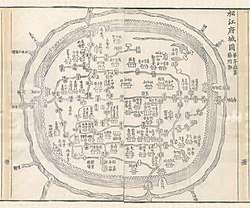Songjiang Town
Songjiang (Chinese: t 松江鎮, s 松江镇, p Sōngjiāng Zhèn; Shanghainese: Son1-kaon1 Tsen3), formerly romanized as Sungkiang, was a large town and the seat of Songjiang County in Shanghai. In 1998, Songjiang County was changed to Songjiang District and, in 2001, Songjiang was abolished to become Yueyang Subdistrict (岳阳街道).[1] Songjiang is located south west of Shanghai city proper.

The town's Fangta Park has a Song-era square pagoda and nearby a 4-meter-high (13 ft) and 6-meter-long (20 ft) Ming-era screen wall, decorated with carvings of legendary beasts that depict human failings and misfortunes. It also has the Mazu Cultural Palace, a temple to the Chinese sea-goddess Mazu, a deified medieval Fujianese teenager. The temple was previously located in downtown Shanghai, but its ruins were moved and reassembled for Songjiang's park.
West of Songjiang is an old mosque, part of which dates to the Yuan dynasty and is said to be one of the oldest Islamic buildings in China.[2] Even today it is still a place of Muslim worship.
Most of the Chinese men fighting in the Ever-Victorious Army against the Taiping Rebellion in the 1850s were originally from Songjiang.
References
- "2001年松江区行政区划 (Songjiang District Administrative Divisions, 2001)" (in Chinese). xzqh.org. Retrieved 2011-04-18.
(9)撤销松江镇建制,建立岳阳街道办事处。岳阳街道办事处的管辖区域为原松江镇的部分行政区域,面积5.8平方千米;办事处设在原松江镇政府的所在地。
- "Shanghai Songjiang Mosque". muslim2china.com. Retrieved 18 January 2015.